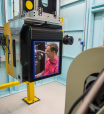Fusion research in Australia
Australia part of global renaissance in fusion power research symbolised by ITER experiment

Showing 41 - 60 of 62 results
Australia part of global renaissance in fusion power research symbolised by ITER experiment
The nuclear analysis team at ANSTO recently had a significant role in the re-design and optimisation of a cold neutron source facility for the reactor, its installation and the subsequent restart after a six-month shutdown.

Dr Meng Jun Qin is a materials scientist with expertise in computer modelling

Hamish is a Chartered Engineer (CEng, MIChemE) with plenty of experience of the pharmaceutical industry and fresh experience in nuclear medicine having recently joined ANSTO.
Research elucidates how in situ cosmogenic radiocarbon is produced, retained and lost in the top layer of compacting snow (the ‘firn layer’) and the shallow ice below at an ice accumulation site in Greenland.

Raghav completed a double degree in Mechatronics Engineering and Computer Science and is currently working with the Electrical Engineering Team at the Australian Center for Neutron Scattering.


Nick is a radiation biologist who works for the NST Human Health research theme.




Dr Carol Azzam Mackay is the Design and Innovation Manager at nandin, ANSTO’s Innovation Centre.


Pamela is an Executive leader with a background in technology, mining, geoscience, operational and corporate roles in public and private sector corporations and NFPs in Africa and Australasia.

Andrew Peele was appointed Group Executive for ANSTO Nuclear Science and Technology in July 2021 and was Director of the Australian Synchrotron from 2013 -2021. He is an adjunct Professor of Physics at La Trobe University.

In June 2022 Miles was appointed to a new role of Group Executive Nuclear Safety, Security and Stewardship with responsibility for all nuclear safety and security operations at ANSTO as well as coordination of al

The High Performance Macromolecular Crystallography beamline will enable the study of very small (sub-5 micrometre) or weakly diffracting crystals, providing a state-of-the-art high-throughput facility for researchers. MX3 will be able to study the structures of large proteins and protein complexes for virology, drug design and industrial applications via goniometer mounted crystals, in-tray screening, or via serial crystallography methods.
The X-ray Fluorescence Nanoprobe beamline undertakes high-resolution X-ray microspectroscopy, elemental mapping and coherent diffraction imaging – providing a unique facility capable of spectroscopic and full-field imaging. Elemental mapping and XANES studies will be possible at sub-100 nm resolution, with structural features able to be studied down to 15 nm using scanning X-ray diffraction microscopy.

